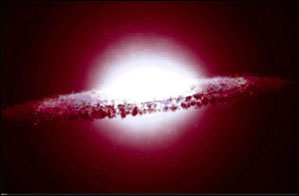Unhypnotized
Truth feeder
by Gary Vey for viewzone The idea of a new planet being discovered in our Solar System is pretty exciting. Even more so because of the many theories about "planet-x" or "Nibiru" being associated with space aliens and the doomsday prophecies of 2012.
Scientists at places like NASA and famous observatories have deflected inquiries about the discovery for a few years now, mainly because they feared being associated with these "fringe" theories. But like it or not -- it has happened. Well... according to a team of Spanish artronomers who call themselves the StarViewer Team.
The group made the rounds of all the news web sites in the past two weeks, claiming they discovered something very significant. It's almost twice the size of Jupiter and just beyond our furthest planetoid, Pluto. Although it's not a planet, it appears to have planets or large satellites encircling it. It's what astronomers call a "brown dwarf star" and its official name is "G1.9".
What's a Brown Dwarf Star?
First we'll explain WHAT these astronomers have discovered. Then we'll discuss HOW they discovered it.
At the risk of being scientifically vague, I'll try to explain the current understanding of how stars and planets form in space.
All matter attracts other matter. A larger mass will attract smaller masses towards it. In space this results in growing clouds of matter that tend to clump together and attract more matter. Since most of the matter in space is gaseous, these clouds eventually get so dense that they collapse into dense gaseous spheres. When they do this there is usually some "left over" matter that forms a ring around the sphere.
 If there is enough matter in a sphere of hydrogen, for example, it can cause so much compression at the shpere's core that the hydrogen atoms begin to fuse together and a fusion-reaction ignites a new born star. In this reaction two hydrogen atoms join together to form one helium atom and release extra energy as radiation.
If there is enough matter in a sphere of hydrogen, for example, it can cause so much compression at the shpere's core that the hydrogen atoms begin to fuse together and a fusion-reaction ignites a new born star. In this reaction two hydrogen atoms join together to form one helium atom and release extra energy as radiation.
Scientists believe that the minimum mass needed to ignite a sun is about 13 times the known mass of the planet Jupiter -- written as "13MJ." If the mass is lower than this, the pressure in the core is not enough to ignite and the sphere will be hot ball of gas called a "brown dwarf."
As a new star spins, the disk surrounding it gradually cools and the matter forms heavier elements like metals and minerals. These "rocks" eventually clump together and form solid spheres called planets.
Sometimes a solid sphere will attract some of the gas that is in the disk and this will result in a gaseous giant, like Jupiter and Saturn, which has a solid core but a thick gaseous atmosphere. These "gas giant" planets can be very massive but, because of their solid cores, they will never ignite and become stars.
http://viewzone2.com/browndwarfx.html
Scientists at places like NASA and famous observatories have deflected inquiries about the discovery for a few years now, mainly because they feared being associated with these "fringe" theories. But like it or not -- it has happened. Well... according to a team of Spanish artronomers who call themselves the StarViewer Team.
The group made the rounds of all the news web sites in the past two weeks, claiming they discovered something very significant. It's almost twice the size of Jupiter and just beyond our furthest planetoid, Pluto. Although it's not a planet, it appears to have planets or large satellites encircling it. It's what astronomers call a "brown dwarf star" and its official name is "G1.9".
What's a Brown Dwarf Star?
First we'll explain WHAT these astronomers have discovered. Then we'll discuss HOW they discovered it.
At the risk of being scientifically vague, I'll try to explain the current understanding of how stars and planets form in space.
All matter attracts other matter. A larger mass will attract smaller masses towards it. In space this results in growing clouds of matter that tend to clump together and attract more matter. Since most of the matter in space is gaseous, these clouds eventually get so dense that they collapse into dense gaseous spheres. When they do this there is usually some "left over" matter that forms a ring around the sphere.

Scientists believe that the minimum mass needed to ignite a sun is about 13 times the known mass of the planet Jupiter -- written as "13MJ." If the mass is lower than this, the pressure in the core is not enough to ignite and the sphere will be hot ball of gas called a "brown dwarf."
As a new star spins, the disk surrounding it gradually cools and the matter forms heavier elements like metals and minerals. These "rocks" eventually clump together and form solid spheres called planets.
Sometimes a solid sphere will attract some of the gas that is in the disk and this will result in a gaseous giant, like Jupiter and Saturn, which has a solid core but a thick gaseous atmosphere. These "gas giant" planets can be very massive but, because of their solid cores, they will never ignite and become stars.
http://viewzone2.com/browndwarfx.html
